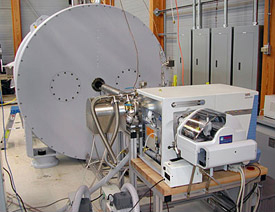
The lab's 14.5 tesla FT-ICR machine.
Fourier-transform ion cyclotron resonance (FT-ICR) mass spectrometry is a technique that depends on magnets. We are identifying the individual components that make up a very complex mixture. We take molecules or atoms and, in order for them to be analyzed by the magnet, they have to be charged. So once we do that we have an ion. The ions are put in the center of the magnetic field. They experience something that's called a Lorenz force, which bends them into a circular path. So the ions are going round and around inside the magnetic field. In ICR we detect the frequency at which they're going around, and that frequency is inversely proportional to their mass. So the bigger the ion, the heavier the ion, the slower the frequency, the slower it goes around. And the lighter the ion, the faster the frequency, the faster it goes around. We simply detect the ion's motion and determine the frequency at which it's going around. That allows us to measure the mass of molecules so accurately that you can determine how many carbons, hydrogens, nitrogens, oxygens or even sulfurs are in the molecule , and you can count those simply be weighing it.
The applications for ICR are rather wide, everything from biological applications for the analysis of proteins, peptides and lipids to food applications, as well as petroleum – one of the most complex mixtures known to man. From a single mass spectrum we can identify 30,000 or more different species that are present in the crude oil. We're at the MagLab because the size of the magnet matters – the field. The bigger the field, the higher the frequency, the more accurate and the higher resolution the measurements. So we can determine the composition of more and more complex materials.


